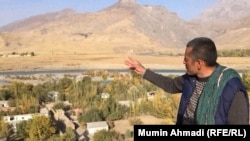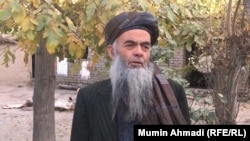Asamuddin Mukhdum, a young Afghan, sees his ancestral homeland every day but cannot visit despite being only separated by a fast-flowing river amid scenic mountains.
Standing in the graveyard in northeastern Afghanistan’s Badakhshan Province, Mukhdum has a bird’s eye view of his ancestral homeland in Tajikistan’s Gorno-Badakhshan region across the Pyanj River.
Yet a quarter-century after the demise of the Soviet Union, Mukhdum is among tens of thousands of Tajiks whose ancestors fled their homes to escape Bolshevik oppression nearly 90 years ago but have yet to return to their homeland and be reunited with their families.
Mukhdum, whose family lives in Badakhshan’s Khwahan district, says his ancestors fled Gorno Badakhshan’s Darvoz region in the 1930s. He says their community included many literary figures who fled communist persecution.
“There are writers and poets here who came from Bukhara and Kulob; there were all migrants,” Mukhdum said while pointing to marble tombstones in the graveyard on top of a hill alongside the Pyanj River. “This grave is of Mullah Abdul Hakim. The grave of Mullah Abdullah is there, and Mullah Barat’s grave is in the center of [Khwahan] district.”
According to RFE/RL Central Asia specialist Bruce Pannier, an exodus from Central Asia toward Afghanistan began in 1916 when colonial master Tsarist Russia started conscripting people from Central Asia for military service in Europe during World War I.
He says the arrival of Bolshevik forces in 1917 was initially greeted with enthusiasm by many in Central Asia as these new Russians promised equality for all the peoples of the new country: the Soviet Union.
“But it quickly became apparent to people in Central Asia that equality meant drastically changing their way of life,” he said. “Religion was to be banned and women emancipated, changes the overwhelming majority of Central Asians did not support.”
More than 100,000 Central Asians joined Mohammad Alim Khan, the Amir of Bokhara, to flee into Afghanistan in 1920. His forces suffered a crushing defeat at the hands of the Red Army.
The Soviet campaign continued for decades forcing wealthy elites, clerics, nationalist figures, and “Basmachi” rebels to seek refuge in Afghanistan.
“This meant families were divided for decades as those living in the Soviet Union were unable to contact those who left for Afghanistan,” Pannier said. “It was only years later, when the Soviet Union invaded Afghanistan [in the 1980s] that some of the Central Asian troops in the Red Army -- Uzbeks, Tajiks, and Turkmen -- discovered they had relatives in northern Afghanistan.”
In Khwahan, Rahmatullah Osman, now in his 90s, was 9 years old when his family fled the Bolsheviks in the 1930s.
“When we immigrated here, Nader Shah was killed [in 1933] and Zhair Shah became the Afghan king,” Osman recalled. “He stopped allowing migrants from Tajikistan. They arrested us and took us to Baghlan Province, where our parents died in confinement.”
Osman still spends his days at his small shop in Khwahan. He now counts 15 children and some 90 grandchildren and great-grandchildren among his family.
Osman finally met some of his relatives after seven decades when he visited Tajikistan nearly 10 years ago.
However, Ismail, now in his 60s, who goes by one name only, has not been as lucky. He says faith drove his ancestors to escape to Afghanistan.
“Our ancestors left all their wealth and just escaped with their lives and faith and crossed the [Pyanj and] Amu Darya rivers to come into Afghanistan,” he told RFE/RL’s Tajik service.
Mukhdum says obtaining a visa to Tajikistan is a tall order. “It’s really difficult to get a visa to Tajikistan in Afghanistan. You need to have a lot of references to get one,” he said.
Tajikistan, Uzbekistan, and Turkmenistan -- three Central Asian countries sharing a border with Afghanistan -- are still largely reluctant to allow a relatively free flow of people and trade across their borders with Afghanistan.
Since 2001, the nongovernmental Agha Khan Development Network has built several bridges across the Pyanj River, which later turns into the Amu Darya, to connect Tajikistan and Afghanistan. But the move has not boosted mobility between the two countries.
“The reunion of families in Central Asia and Afghanistan who have been separated by decades will undoubtedly go a long way toward strengthening ties in an area that did not have a border until some 150 years ago,” Pannier noted.








